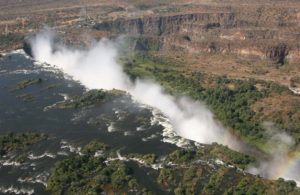If people remember David Livingstone at all, it is as the intrepid African explorer made famous by his meeting with journalist Henry Stanley, at which Mr. Stanley presumably just said, “Dr. Livingston, I presume?” Livingstone had been exploring Africa for three decades, penetrating farther into the African interior than any other European. And on November 17, 1855, he became the first non-African to observe Mosi-oa-Tunya, the amazing waterfall on the Zambezi River.
Livingstone was born in 1813 (died in 1873) to a poor Scottish family. Growing up with six siblings in a one-room attic apartment, he started work at age 10. Hard work, intelligence and devout Christianity gave him the physical, mental and spiritual strength to answer the call to become a medical missionary in Africa. After several years of study, he arrived in Cape Town in 1841, at the age of 28.

He explored throughout southern Africa for 15 years, traveling across the continent from west to east and back again and venturing farther north into what we now call the Congo than any previous European explorer. He provided medical care and taught Christianity, while also fighting against slavery and poor treatment of native Africans. He especially sought a river route across the continent, hoping that it would open legitimate commercial trade on the Atlantic coast to replace slave trading.
Consequently, he explored the Zambezi River, from its mid-continent source to its Indian Ocean mouth in Mozambique. His explorations took him to the area native Africans called Mosi-oa-Tunya, which means “the smoke that thunders.” The smoke was mist and the thunder was the sound of one of the world’s most unique landscapes—what we now call Victoria Falls and its surrounding ecosystem.

Victoria Falls lies on the Zambezi River, which forms a border between Zambia and Zimbabwe. The river is 1.2 miles wide at the falls. A precipice forms a narrow gash in the landscape perpendicular to the water flow. Nine cascades flow over the basaltic lip, extending almost as wide as the river and crashing on the rocks 350 feet below. By both length and height, Victoria Falls is much larger than Niagara Falls. The large flow and long drop create massive spouts of mist that can be viewed from a dozen miles away. The mist also creates a local rainforest-like ecosystem that supports a number of rare and endangered species including several raptors that nest on the cliffs.
When Livingstone arrived at the falls (either on November 16 or 17—accounts vary, but we’ll use the latter), he was awed by the splendor around him. He approached the falls on an island perched on the lip of the gorge:
“In looking down into the fissure on the right of the island, one sees nothing but a dense white cloud, which, at the time we visited the spot, had two bright rainbows on it. From this cloud rushed up a great jet of vapour exactly like steam, and it mounted 200 or 300 feet high; there condensing, it changed its hue to that of dark smoke, and came back in a constant shower, which soon wetted us to the skin….”
Long considered one of the natural wonders of the world, Victoria Falls is among Africa’s biggest tourist attractions. Nearly 500,000 people visited during 2016, and visitation took big jumps in both 2017 and 2018. A new airport, capable of accommodating large jets, and modern hotels are making travel more convenient and affordable.

The falls are protected through two national parks that contain the falls and the lands above and below them. One is in Zambia (Mosi-oa-Tunya National Park) and one in Zimbabwe (Victoria Falls National Park). UNESCO placed the Victoria Falls region on its World Heritage List in 1989, noting that the Victoria Falls is “the world’s greatest sheet of falling water and significant worldwide for its exceptional geological and geomorphological features and active land formations processes with outstanding beauty attributed to the falls i.e. the spray, mist and rainbows.”
The world today agrees with Livingston’s appraisal, when he called the falls “the most wonderful sight I had seen in Africa” and named them in honor of Queen Victoria. Or call it Mosi-oa-Tunya, your choice.
References:
Africa Albida Tourism. 2017. A tourism survey of the Victoria Falls region. Available at: https://gallery.mailchimp.com/44d89d6770f14113ea889729c/files/040c7db8-4834-44c0-9de4-7a6b786341ff/Africa_s_Living_Soul_2016_low_res_.pdf. Accessed October 28, 2018.
Roberts, Peter. To The Victoria Falls. Available at: https://www.tothevictoriafalls.com/vfpages/discovery/discfalls.html. Accessed October 28, 2018.
Shepperson, George Albert. David Livingstone, Scottish Explorer and Missionary. Encyclopedia Britannica. Available at: https://www.britannica.com/biography/David-Livingstone. Accessed October 28, 2018.
UNESCO. Mosi-oa-Tunya/Victoria Falls. World Heritage Centre List. Available at: https://whc.unesco.org/en/list/509. Accessed October 28, 2018.
